I think I’ve read nearly every possible argument on the subject of the best cutting board material in the years I’ve been cooking and I am still not sold that there is just one best material for cutting boards. I’ve come to the conclusion that each material has it’s own benefits and drawbacks and as such have a few different materials in my own kitchen. First, let’s look at the available materials for cutting boads.
Wooden Cutting Boards
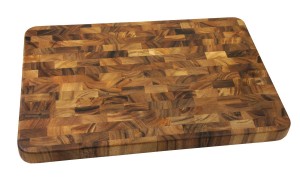
Wood cutting boards, sometimes called “butcher block” cutting boards, have been highly regarded for quite some time as a sign of quality and professionalism. I agree that they look wonderful and definitely add a sense of elegance when compared to plain old plastic cutting boards. Most people though, don’t know that there are different types of wooden cutting boards but when you find out more about the different types it makes perfect sense.
Consider Different Wood Materials
There are a number of different types of wood, so naturally there can be many different types of cutting boards made from the various wood types. When choosing a wooden cutting board consider the type of wood that you want for the board and not just the fact that a wooden cutting board is not plastic. In my opinion, the primary consideration of the type of wood to use is the durability of that wood. If you are selecting a softer wood (pine, for example) then your cutting board will wear much quicker and also show cut marks much more. If you select one that is very dense such as Ironwood, it may be much heavier and harder on your knives but last much longer.
End Grain vs Edge Grain Wooden Cutting Boards
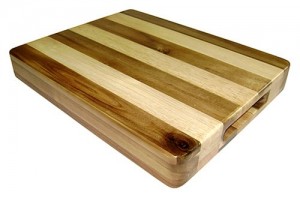
End grain cutting boards consist of many smaller pieces of wood laminated together and can look like a checkerboard like the first picture on this page. The grain in the wood runs from the top surface of the cutting board to the bottom surface. Generally speaking, end grain wooden cutting boards provide a harder cutting surface due to the direction of the grain against the knife blade. This can translate to a longer lasting cutting board. Edge grain cutting boards like in the picture to the right, are essentially strips of wood attached side by side for the length of the cutting board. Butcher block counter tops are primarily constructed in a similar fashion. The picture to the right shows a large contrast between the wood finishes, but many times they use the same wood and finishing on each strip making them hardly distinguishable other than the wood grain.
>> Explore Wooden Cutting Boards
Bamboo Cutting Boards
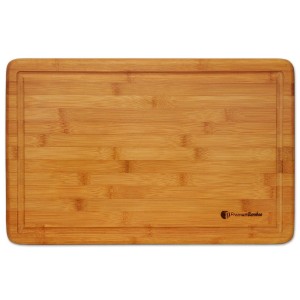 Some people will call bamboo “wood” but it is in fact a grass. Besides this factual difference, visually it is still a natural wood-like product that cutting boards are made from. Bamboo is harder than many woods and thereby can last longer as a cutting board, but may also be harder on knife blades. One big selling point for some people is the renewable nature of bamboo since it grows so much faster than wood. Bamboo cutting boards can be more expensive than wooden cutting boards and have a distinctive look to them. They can also be end and edge grain in construction. The fibrous nature of bamboo can – in some cutting boards – have some small ridges that can interfere with cutting actions.
Some people will call bamboo “wood” but it is in fact a grass. Besides this factual difference, visually it is still a natural wood-like product that cutting boards are made from. Bamboo is harder than many woods and thereby can last longer as a cutting board, but may also be harder on knife blades. One big selling point for some people is the renewable nature of bamboo since it grows so much faster than wood. Bamboo cutting boards can be more expensive than wooden cutting boards and have a distinctive look to them. They can also be end and edge grain in construction. The fibrous nature of bamboo can – in some cutting boards – have some small ridges that can interfere with cutting actions.
>> Explore Bamboo Cutting Boards
Cleaning & Maintaining Wood and Bamboo Cutting Boards
Wooden and bamboo cutting boards need to be cleaned and maintained in a way that preserves the natural qualities of the material and won’t warp the cutting board. I will cover this in detail in a separate post but wanted to summarize the work required here for potential shoppers to consider before making a purchasing decision. In a nutshell, here’s what’s required for cleaning and maintenance of wooden cutting boards (much of this will apply to bamboo also) in no particular order.
- They are not dishwasher safe. Using the dishwasher to clean a wooden cutting board may result in delamination, warping, fading and generally just ruin your nice cutting board.
- You should not soak or saturate a wooden cutting board, for the same reasons as not using the dishwasher to clean it.
- A specific cleaning method is required.
- Occasionally after prolonged use you may need to sand the board to remove grooves or gouging.
- You will occasionally need to oil the cutting board to keep the wood from splitting
All this being said, I have a wooden cutting board I completely neglect and it has not exhibited any major issues other than some very slight warping that I can live with. I have not cleaned it in the dishwasher though – that’s a big no-no!
Plastic or Composite Cutting Boards
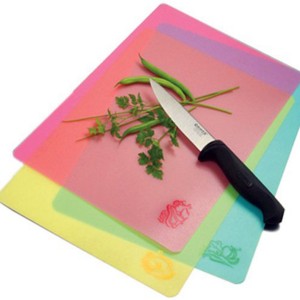 Is there anything that isn’t made out of plastic now-a-days? Cutting boards are no exception. However, not all plastics are created equal and just because something is made from a synthetic material doesn’t mean it is truly “plastic” from a technical standpoint. Most plastic cutting boards are made from polyethyline (PE) or high-density polyethyline (HDPE) and are relatively cheap to purchase.
Is there anything that isn’t made out of plastic now-a-days? Cutting boards are no exception. However, not all plastics are created equal and just because something is made from a synthetic material doesn’t mean it is truly “plastic” from a technical standpoint. Most plastic cutting boards are made from polyethyline (PE) or high-density polyethyline (HDPE) and are relatively cheap to purchase.
One of the major drawbacks of plastic cutting boards are their lack of durability long term. Once a plastic cutting board is scored or gouged significantly, it no longer provides any inherent benefits over a wood cutting board, and may even harbor more bacteria than a comparable wooden cutting board. Plastic cutting boards do, however have some advantages:
- Price. Plastic is cheap.
- Thin, flexible cutting boards allow for easy transfer of ingredients.
- Weight. Plastic cutting boards can be much lighter than a comparably sized wooden one.
- Dish-washer safe. Being able to wash your board in the dish washer can be a big benefit.
>> Explore Plastic Cutting Boards
Glass, Steel & Stone Cutting Boards
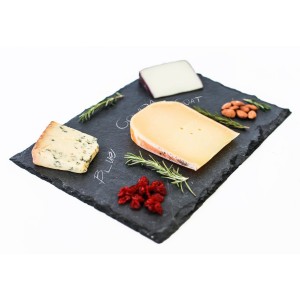 Personally, I don’t regard anything made from these materials as “cutting” boards as much as a display or serving piece. Cutting directly on glass, wood, stone or any other hard surface is a great way to ruin a good knife. You can gouge the surface, chip your knife, roll the blade edge or even worse hurt yourself.
Personally, I don’t regard anything made from these materials as “cutting” boards as much as a display or serving piece. Cutting directly on glass, wood, stone or any other hard surface is a great way to ruin a good knife. You can gouge the surface, chip your knife, roll the blade edge or even worse hurt yourself.
What else can I say here? If you choose to cut on one of these surfaces then I doubt anything I will will say in addition to the above will convince you that these super hard materials are not suitable for actual cutting use.
That being said, from a display perspective, a piece of stone, steel or glass can be very elegant for serving cheese, charcuterie or even entrees and may be something you want to consider in your kitchen.
In summary, I would call these things a cheese board or serving piece more than an actual cutting board.
So, What’s the Best?
In my opinion, there is no single best material for a cutting board. Every material has its own strength and weakness and should be utilized in a way to take advantage of their strengths.
Here is what I have in my kitchen:
- Large, primary wooden cutting board. I use this for nearly everything other than raw meats. It is a general purpose cutting station.
- Large plastic cutting board. This is for everything else that shouldn’t be cut on a wooden cutting board, especially raw meats.
- Multiple serving boards made from wood, glass and stone. These are display pieces that are great for having company over.
- Multiple “cheap” plastic cutting boards. I have sets of flexible plastic ones, and smaller rigid plastic ones that offer plenty of extra cutting areas should the primary one be in use.
What About You?
What kinds of cutting boards do you have in your kitchen? Are you satisfied with just one?

I used to work in restaurants and had those yellowish rubber type cutting boards, but didnt look so great even when new . Great for knive edges though ..now of any newer morden looking ones that show better ? Thanks